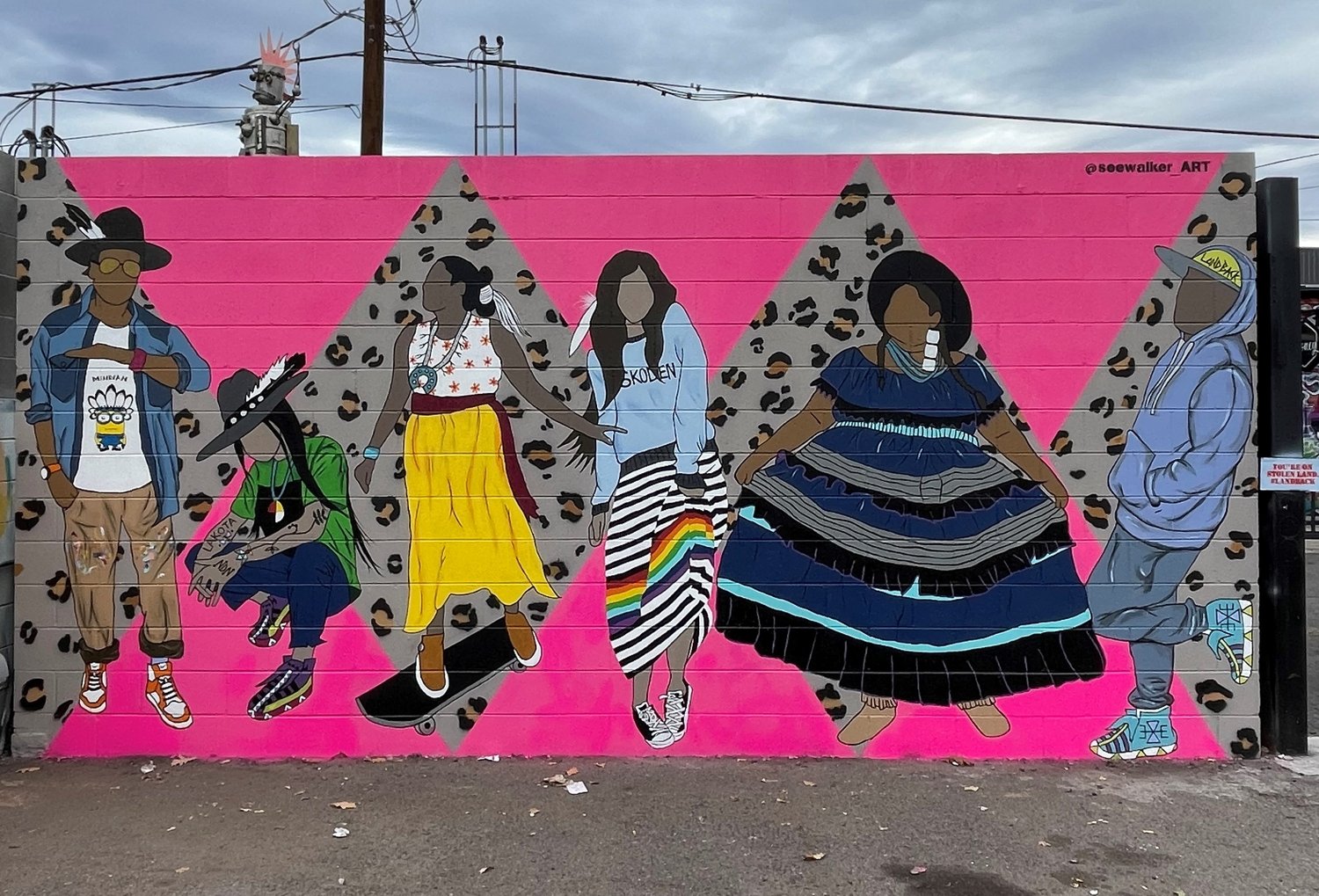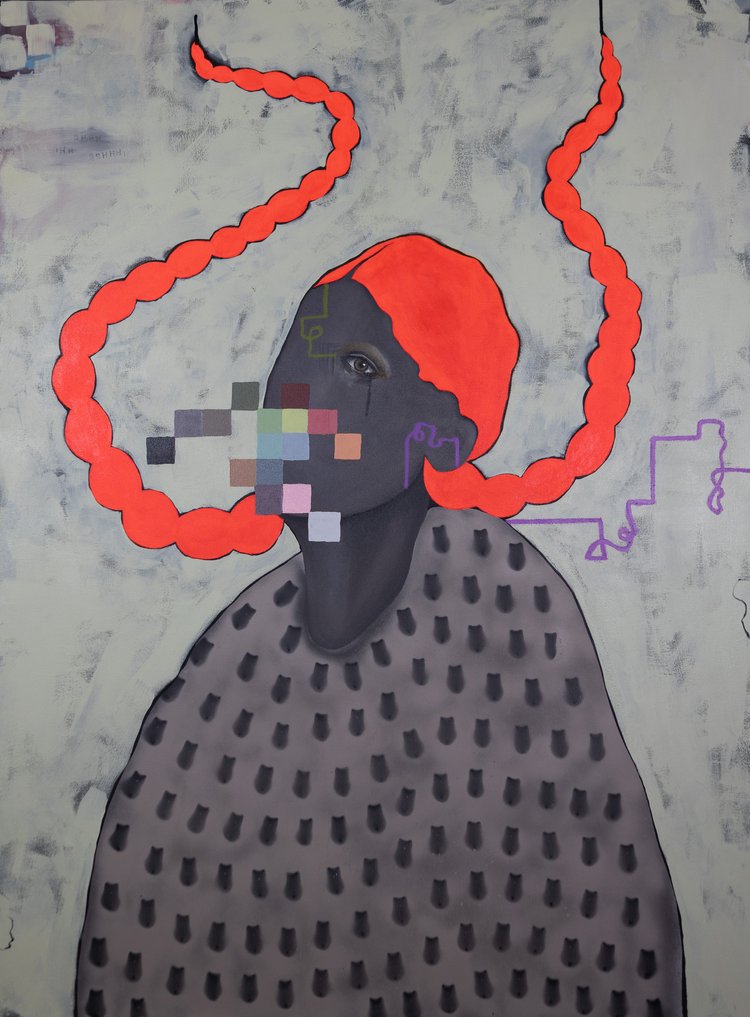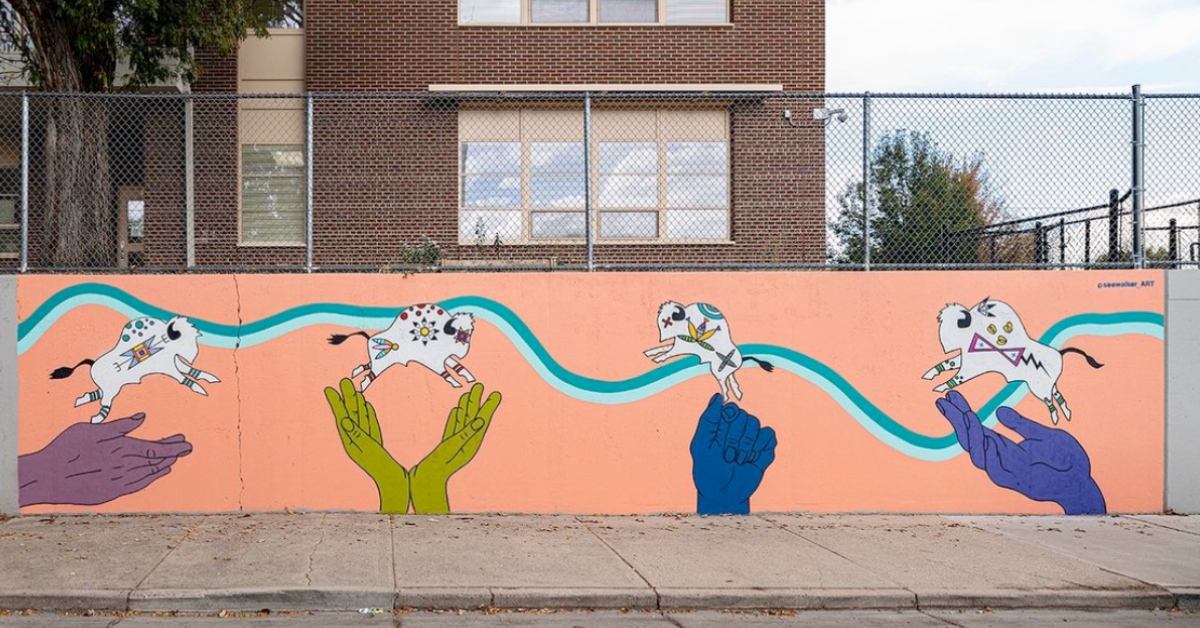Danielle SeeWalker, Buffalo Run, 2023. Mural commissioned for the Brown International Academy in Denver, CO.
Arts & Culture Advocacy Program: A couple of months ago, news outlets reported on the cancellation of your artist residency with Art in Public Places in Vail, Colorado. How did the residency first come about?
Danielle SeeWalker: In January of this year I received an e-mail from the Arts In Public Places Coordinator, Molly Eppard. She reached out and said she’d been a fan of my work for a very long time. She explained the activities of the Arts In Public Places (AIPP) program and that they had an Artist Residency coming up, and that they’d love to get me on a call to chat more about that, and see if it could be something I’d be interested in, because they’d love to have me be part of it.
ACAP: Did she say anything about what drew AIPP to you and your work?
DSW: I know she was intrigued by the fact that I am Native American, and she personally liked my artwork. She had shared some examples of my work with some other folks on the AIPP board, and they also really liked it. They said they wanted to bring diverse voices to Vail and so that was sort of a centering theme as well, bringing diversity into their town.

Danielle SeeWalker, Still Here, 2021. Mural located in downtown Denver, CO.
ACAP: What were the components of the residency?
DSW: It started as a mural commission. Together, over the next several months, we identified a location and a wall space in Vail, where the mural would go. Along with that, AIPP wanted to have more interaction and engagement with the community, so we brainstormed other things that could happen during my residency. The mural was a big part of it, but I was also going to do a workshop in the community where I would teach traditional art, as well as participate in an artist talk, plus have a solo exhibition of a photo documentary project I had been working on. At the time of the cancellation, the artwork selections for that photography exhibition had already been curated and finalized by the AIPP team.

Danielle SeeWalker and Carlotta Cardana, Fast Eddie and Two Braids, from the Red Road Project, 2020. This was one of the images pre-selected by the Town of Vail for the exhibition element of SeeWalker’s AIPP Residency.
ACAP: In your experience as a professional artist, you have been commissioned to do several murals. What is the typical process of proposal and approval for these kinds of projects, and what were you expecting with regards to this artist residency project?
DSW: The discussions about the Vail mural commission were similar to other mural projects I’ve been part of: first, I asked for photos of the wall they wanted the mural on, as well as its dimensions so that I could provide a quote, and I listed the supplies I would need, and so forth. So they sent me photos and dimensions, and I sent a quote. They indicated that things sounded good, and described what they could offer, and we kept moving forward.
The next step was a site visit. So I drove to Vail for a day, looked at the wall, and met with the AIPP director as well as an AIPP board member. I asked my usual questions, like: what should be included, if anything, and what should not be included, if anything. A lot of people are sensitive, and might not want particular words or phrases, etc. So I always ask those questions. They told me that I had full creative direction, but there would need to be an approval process and so there was a timeframe they provided in which they asked me to submit a concept sketch which they would then present to their board.
I never got to that phase because Vail’s AIPP Program literally canceled the residency the week before I was supposed to deliver the concept. I didn’t even have the opportunity to give them what I was going to design.
ACAP: How did you learn that the Town of Vail was going to cancel the residency?
DSW: I was on flight and I got a phone call from AIPP, which I couldn’t answer. But, I had internet so I texted with Molly over Wi-Fi. She said we needed to chat as soon as possible because there were some concerns around my residency that she and I needed to discuss. Immediately I thought, Oh, this does not sound good. I told her I’d be landing in a few hours and asked about speaking to her then, and whether she could share any information over text. That’s when she indicated the concerns were related to my G is for Genocide painting. She indicated that there were members of Vail’s Jewish community who had concerns about that work and that, because of this, she and I needed to talk about my residency. I just immediately had the feeling that this residency was going to be canceled.

Danielle SeeWalker, G is for Genocide, 2024.
ACAP: What was this artwork that suddenly became conflated with your residency?
DSW: G is for Genocide is a painting of a Native American woman wearing a keffiyeh in solidarity. Aside from the keffiyeh, there’s nothing else visually in the painting that screams “politics,” “genocide” or anything. Obviously, the title of the artwork is G for Genocide, but that’s it.
I created G is for Genocide months earlier, at the end of February 2024 for an all-women/nonbinary group mural exhibition in Denver. I painted the work pretty quickly because it was something that had been on my mind for a few months since the start of the war in Gaza. The more I was learning about the war, I just kept seeing so many parallels between what’s happening there and what happened to Native American people here in the country. Sometimes the best way that I can express what I’m thinking and feeling as an artist, and as a very visual person, is to just get it out visually with art. I often don’t have words for it, but I wanted to convey what I was feeling. The work is centered around my interpretation of solidarity, and the feeling that Native Americans have been through something very similar to what the Palestinians are going through.
So that’s how that painting came about. On the opening night, it was the first piece that sold in the show. It got a lot of positive reactions. People told me things like, “wow, this piece is great,” “I appreciate you doing this.” It created a lot of discussion.
ACAP: So you were probably pretty eager to get off the flight and clarify things.
DSW: Yeah, as soon as I landed I called Molly. She did not answer. So I texted her and said that I’d love to chat and see what’s going on. She replied, asking to speak over the phone on the coming Monday, which was in a few days. So I agreed to that. Then Monday came, and it was about 8:00 AM that Molly called me on the phone with the Deputy Town Director, Kathleen Halloran—somebody I’d never spoken to before, had never met, and someone I never had any interaction with.
Kathleen introduced herself and said something to the effect that they were canceling my residency because I was being too political, and that they can’t have someone like me coming into their town to create art with a political message. I was shocked. I tried to get a word in edgewise, but the whole conversation probably lasted 2 minutes. And I tried to explain how that painting, which had been created two months earlier, had nothing to do with the residency and how I would love to understand why an unrelated painting would affect my residency.
But I just never got that opportunity to talk to them about it. I was basically told the residency had been canceled, and that was it.
ACAP: Once you learned that G is for Genocide was being invoked as a reason to cancel your residency, what was your reaction?
DSW: At first I was completely shocked and stunned. Like how could this conversation last just two minutes? I didn’t even get an opportunity to understand where they were coming from. I didn’t get an opportunity to address their concerns… namely that G is for Genocide is the only painting of mine, out of so many others, that has anything in it relating to Palestine. G is for Genocide was a one-off thing, that should have had nothing to do with the residency.
My second reaction was that this is not right. I’m very heavily engaged with a lot of media contacts because I do a lot of legislation work and human rights work. I immediately thought, I’m going to call all my media contacts and share what’s happening, because I want to talk about it and make this public. And little did I know that it was going to blow up locally.
After it hit the media, I let the dust settle a little bit and then sent AIPP an e-mail and an invoice because they canceled everything in such a short time period before the residency was supposed to start. But they would not talk to me. They never called me. They never tried to set up a meeting with me to discuss it after the fact. They did issue something on their Instagram that made it seem like they were willing to work with me, which I thought was interesting because they never attempted to work with me, pay me, or anything. Eventually, they responded that they’d pay my invoice if I’d be willing to sign some kind of document. I had an attorney look over the document, which was basically a non-disclosure agreement that also would prevent me from taking legal action over what happened. I didn’t sign it.

Danielle SeeWalker and Carlotta Cardana, Sitting Bull St., from the Red Road Project, 2013. This was one of the images pre-selected by the Town of Vail for the exhibition element of SeeWalker’s AIPP Residency.
ACAP: So the residency was canceled, but from what I understand, you were still able to participate in the panel discussion, which was hosted by a different venue in Vail. Did the event include any discussion about the canceled residency?
DSW: The panel discussion element of the residency was to be hosted by the Vail Symposium, which is a separate organizational entity from the Town of Vail, which hosts the AIPP residency. About 24 hours after the cancellation became public, someone from Vail Symposium reached out, indicating they still wanted to host my talk. I sat with that invitation for a little bit. I didn’t make a decision right away because it would have been more of an emotional decision. After a few days, I concluded that in the immediate aftermath of the cancellation, I never had the opportunity to have a voice. AIPP and the Town of Vail never let me explain myself or anything. So I thought that this panel at Vail Symposium could be a great opportunity for me to go into the community and do just that. I decided to take part in it.
What I found interesting was that the Vail Symposium wanted to do several rounds of pre-planning meetings where I had to get on a call with probably four or five representatives to review what we could discuss, what we should not discuss, and security measures. It was kind of ridiculous and blown out of proportion, but I went along with it, thinking that I can do whatever makes them feel more comfortable.
In those discussions, it was very clear that they did not want me to talk about G is for Genocide, which felt like continued censorship. Especially when they said “we welcome diverse voices and we welcome challenging conversations.” And yet they didn’t.
I explained to Vail Symposium panel organizers that G is for Genocide is part of my body of work, and is something that undeniably created an issue with my residency. For me to come into Vail and not talk about this work is going to be very awkward and uncomfortable, especially for audience members, because they’re probably curious to know a little bit about that work and what happened. So I disagreed with them and said that if I participate, I can’t promise that I’m not going to talk about that work.
When I arrived at the panel, I found it interesting that there were a lot of police officers there at all times, which I have never seen at an artist talk. I don’t know why they decided to have them there. But there was a Q&A session where somebody asked about the residency. The moderators interrupted and said something like, “No, we’re not going to talk about that. You’re welcome to talk about that with Danielle after the event, as we’re not going to have space to talk about that here,” and didn’t let me chime in. So, it was just an awkward situation.
I did insert myself at one point and just acknowledged the elephant in the room, that this residency cancellation did happen. I would be doing a disservice to myself if I didn’t talk about it or speak up. So I talked a little bit about it.

Danielle SeeWalker, But I Have Something to Say, 2022
ACAP: What has the process of speaking out been like?
DSW: I think that, in coming from a population of people and a culture that has been constantly denied the opportunity to have a voice and that is constantly responding to attempts at cultural genocide and forced assimilation, and growing up having experienced a lot of prejudice and racism as a Native American, I entered my adulthood familiar with fighting back.
I also work in legislative rights and I do a lot of different things to support Native American voices. And so for me, it was natural to speak out. In my mind it was more about the principle of resisting that silencing effect, because it is going to be a detriment to future artists who might want to come work in Vail, or it might shape opportunities that are available in that region. And it might make other people think that it’s okay to silence artists.
I also felt tokenized in this experience, in that Vail’s AIPP approached me saying they loved my artwork and really wanted to bring diversity to their program by having me as a Native American artist participate. But then as soon as I didn’t fit the mold of what “diversity” looked like for them, it was canceled.
ACAP: Right. Which totally defeats the point of sharing a stage or a forum. Has this experience informed or shifted your perspective on art censorship?
DSW: I hadn’t really heard much about art censorship before this, aside from a few cases here and there. But after it happened to me and it got media attention, I had so many people reach out to me saying that something similar happened to them. So many artists have shared stories about how they had to walk away from certain projects because of censorship, so they were appreciative that I spoke up about it.
Until now, I didn’t realize the frequency with which artistic censorship happens—particularly if you show support for Palestine in your artwork. People are losing jobs all over the world because of it. This incident has really opened my eyes that this is a problem that is more common than I thought.


